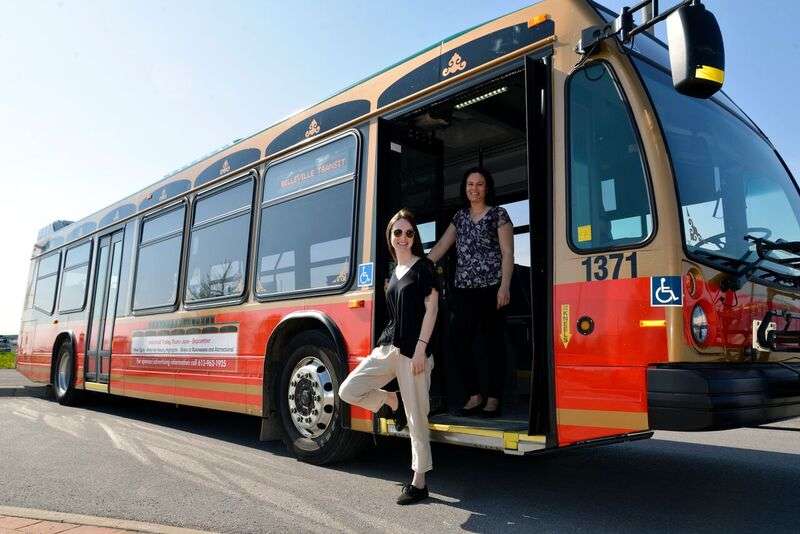When it comes to transportation, cities are facing a moment of reckoning. Private ride-hailing apps like Uber are threatening to cannibalize mass transit. One Canadian community replaced its bus service entirely with Uber.
Belleville, a southern Ontario city of 50,000, is taking a different approach. Locals are trying a new technology on an old form of transportation: the bus. The pilot project, launched Sept. 17, uses the on-demand technology Uber popularized, but instead applies it to public transit.
Videos by VICE
Belleville is piloting the on-demand technology on its night bus route. Riders can call in or use an app to schedule pickups days before their trip, or just a few minutes prior. They get an automatic confirmation, and the time the bus is scheduled to arrive to pick them up. Passengers can also flag down a bus, and the driver can register their ride on the spot.
Belleville city officials are loving it so far. “We don’t have to do that full loop around the city hoping somebody gets on board,” Paul Buck, manager of transit services of the city of Belleville, told me on the phone.
The service is also seeing increased ridership. Prior to the launch, Buck said the night bus route was typically used by 40-45 people a night, mostly shift workers; since the app has launched, more than 100 riders a night have used the route.
The system is entirely automated, thanks to demand/response software designed by Toronto fleet-management software company Pantonium—no dispatcher needed. “Our technology is running the whole operation on its own,” said Remi Desa, CEO and co-founder of Pantonium.
Low-density areas are hard to serve with efficient transport, said Desa. To design the demand/response system for Belleville’s microtransit service, Pantonium “looked at approaching this from a route-optimization perspective, where you have a fixed number of [vehicles] and people going to different places at different times.”
Buck said the technology lets the city do more with the resources it has. “It gives us an opportunity to cover more area and pick up more people, but with less driving, less wear and tear on the vehicle, and more certainty for the customer,” he said. He hopes the city will extend the program past its pilot phase.
Belleville has the same transportation problems as many small communities throughout North America. Municipalities have limited funds to run bus service, a lack of population density, and a lot of ground to cover.
Some communities have sought to rectify this problem by replacing their transit systems with private ride-hailing apps. The small town of Innisfil, Ontario, is now massively subsidizing Uber, a private company that is known for playing hardball to get what it wants out of legislators, in a bid to save the city money.
Read More: This Town Considered Starting a Bus Line But Will Just Pay Uber Instead
But if Uber ever pulls out of the deal, the town may have to start again from square one.
Keeping transit public is fundamental to improving social equity, explained Art Guzzetti, VP of policy at the American Public Transportation Association (APTA). Hiring private contractors is fine, he told me in a phone interview, ”but the umbrella overtop mobility should be public. It’s not for regulation; it’s for the common good.”
To fend off the continued decline of public transit ridership, agencies and municipalities need to adapt to the new model of on-demand transportation, said Guzzetti. Doing first-mile/last-mile trips (bringing people to a bus, metro, or train stop) with pooled, on-demand transport, rather than individual private rides, keeps these communities from cannibalizing their fixed-transit network.
“This new mobility paradigm is very good,” Guzzetti said. “We’re figuring it out one pilot program at a time, but there has to be some kind of policy framework around it.”
The transit agency in Austin, Texas, last year ran a similar pilot to Belleville’s called Pickup in a few subdivisions not previously served by public transit. That pilot aimed to see if the agency could improve mobility in transit deserts efficiently without fixed routes, Tony Lynch, Capital Metro’s supervisor of demand response planning, told me on the phone.
“With [the growth of] on-demand hailing we asked ourselves, ‘Can we operate something like this?’ Because it sounds like a great idea to get people into the service,” Lynch explained.
During the Austin pilot, most users used the service as an area shuttle—for instance, bringing them from their doorstep to the grocery store and back—but a new kind of taxi service wasn’t really the intended purpose. Lynch said the agency will be seeking requests for proposals to create a feeder service that connects smaller communities to the larger urban transit system.
One positive, unintended consequence in Austin was getting “regular” transit and paratransit riders onto the same buses, which improved bus frequency and per-passenger costs. Belleville is seeing this move towards inclusive transit, too, said Buck. This development is encouraging considering the high costs local governments shoulder to subsidize existing paratransit services.
According to Buck, Belleville is possibly the first municipality to deploy such a service on an existing bus line. “Everybody’s watching and waiting and curious,” he told me. “There’s a ton of pressure. This has the potential to be the solution for a lot of problems we’ve had in public transit for a long time.”
Get six of our favorite Motherboard stories every day by signing up for our newsletter.
More
From VICE
-

Christoph Wagner/Getty Images -

Illustration by Reesa. -

-

Malte Mueller/Getty Images
